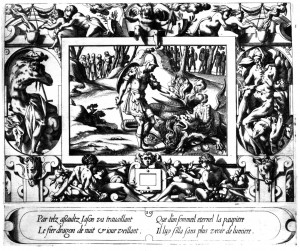Twenty-Six Scenes of the Story of Jason and the Conquest of the Golden Fleece Set in Figured Frames
Engravings by René Boyvin, 15.5 – 16 (not including added plates with texts below of 3.1) x 22.7 – 23.2 P (Vienna).
Fig.RE.15,10 (Vienna)1
Fig.RE.15,26 (Vienna)
Robert-Dumesnil, VIII, 1850, 36-44, 39-64. Le Blanc, 1854-1890, I, 507, 43-68. Destailleur, 1895, 277-278, no. 1151. Linzeler, 1932, 172-176. Adhémar, 1938, 257. Levron, 1941, 66-67, 16-41, Pls. XIX-XLIV.
COLLECTIONS: Amsterdam (De Jong and de Groot, 1988, 251-253, 578.1-21 [Figs. 578.1, 8, 12, 15, 18], as Boyvin after Thiry). Florence, 7927-7934ss, 7936-7945ss, 7947-7970ss, 9860ss. Los Angeles, Ruiz (Schab, 1968, 83, no. 67A). Paris, Ed 3; SNR (incomplete); Ed 6b; Sa 40. Paris, Louvre, Rothchild Collection (P. Jean-Richard, in Seizième Siècle…Rothchild, 1965-1966, nos. 18-19, State I). Rome, Vol. 50-K-71, 93534-93559. Vienna, F.I.3, pp.16-24 (in French); H.B.IV, pp.59-72 (in Latin).
The most complete accounts of these prints and their editions are given by Robert-Dumesnil and Linzeler. They were published in 1563 (Robert-Dumesnil: State II) with texts in Latin or in French and with a dedicatory inscription indicating that they were engraved by Boyvin after designs by Léonard Thiry. Fuhring, 1989, 332, notes that at least two editions are known:
State I, unnumbered; State II, numbered, dated 1563, often bound; 2nd edition, numbers removed, eighteenth century edition by E. Desrochers. The last engraving of the series is inscribed: Leonardus./ thiri inue., and Renatus./ F. In 1699 another edition was published with a title page inscribed: HISTOIRE DE JASON Peinte Par M ROUS A Fontainebleau (Robert-Dumesnil). It is probable that the inscription to Thiry on the last plate of this edition, which has not been seen, was also changed. A later edition (Le Blanc: State IV; Robert-Dumesnil: State III) gives an inscription stating that they are after paintings by Primaticcio at Fontainebleau (and with the address of E. Desrochers, see Fuhring, 1989, above).
These prints and the drawings from which they were made are among the major sources of our knowledge of Thiry’s style (see Mariette, Abécédario, V, 1858-1859, 22, as Boyvin after Thiry; Kusenberg, 1931, 212, n. 365, the drawings as by Boyvin; McAllister Johnson, in EdF, 1972, 199, 200, ills., 202, nos. 225, 226, and 246, ill., 248-249, nos. 283-284; Fontainebleau, 1973, I, 92-93, Figs. 63-66, II, 67-68, nos. 225-226, 78, nos. J and K; K. Wilson-Chevalier, in Fontainebleau, 1985, 115-117, no. 64 [Château-Musée de Nemours], 218-220, no. 165 [Paris, Ed 31, 222, 224, no. 171; Paris, Ed 3]; and Brugerolles and Guillet, 1994, ix, x, 96-103, nos. 33-35, and Figs. of drawings and related prints,2 and 126, under no. 40, and Fig.; Béguin, 1995, 192, noted Thiry’s attempts to transpose Rosso’s invective narrative ideas and decorative language). Thiry is recorded as having died in Antwerp in 1550 or a little before (Kusenberg, 1931, 109, 113), some thirteen years before the dated complete sets. But Robert-Dumesnil indicates that there are some unnumbered impressions that constitute a first state and that it is probable that the numbers were added only when the prints were grouped together as a book in 1563. As these numbers appear on the added plates at the bottom that include the engraved texts, it is possible that the pictorial and ornamental plates were engraved considerably before 1563. For impressions of this first state, see Berliner, 1925-1926, I, Pls. 134-138, Text Volume, 44.
ENAMELS: On enamels made from these prints by Master I.C. (Jean Court?) and others, see B. Jestaz, in EdF, 1972, 452, no. 654 (London, Victoria and Albert Museum); H.P. Mitchell, “The Limoges Enamels in the ‘Salting Collection,’” BM, XX, 1911-1912, 84, and Pl. II; J. J. Marquet de Vasselot, “La Conquête de la Toison d’Or et les émailleurs limousins du XVIe siècle,” La Revue de l’Art ancien et moderne, XXXIV, 1913, 241-243, 333-345; Verdier, 1967, 300, no. 163 (Baltimore, Walters Art Gallery); and Brugerolles and Guillet, 1994, 98-99, with Fig. (Paris, Louvre). There is also an enameled plate in grisaille signed: Z.S. in the Ashmolean, Oxford (M. 251, Mallett Collection).
1 For a figure similar to the old woman used in the border of this print, see RE.8.
2 For no. 33, and its related print, number 13 of the series: Fig.RE.15,13, Drawing, and Fig.RE.15,13.

